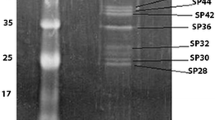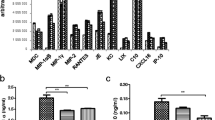Abstract
In vitro proliferation and cytokine production were investigated in BALB/c mice splenic cell cultures that were stimulated with concanavalin A (ConA) and lipopolysaccharide (LPS) and simultaneously exposed to salivary gland extracts (SGE) of unfed and partially fed adult ixodid ticks (Ixodes ricinus, Rhipicephalus appendiculatus, Amblyomma variegatum). Generally, tick SGE enhanced proliferation of unstimulated splenocytes and SGE of unfed ticks suppressed mitogen induced proliferation. Partially fed R. appendiculatus and A. variegatum suppressed ConA responses, while partially fed I. ricinus stimulated both ConA and LPS induced proliferation. A. variegatum and R. appendiculatus females slightly enhanced LPS responses 2 days after attachment but suppressed them at the end of the slow feeding phase. In 72 h ConA induced cell cultures, interferon gamma (IFN-γ) production was suppressed by SGE of all ticks, interleukin (IL)-10 production was enhanced by unfed I. ricinus and partially fed A. variegatum males and IL-5 production was enhanced by feeding R. appendiculatus females and A. variegatum males. The study revealed variability in the responsiveness of murine splenocytes to SGE of different ixodid tick species, whereby patterns of host immunomodulation within one tick species differed between sexes and changed during feeding.
Similar content being viewed by others
References
Andrade B.B., Teixeira C.R., Barral A. & Barral-Netto M. 2005. Haematophagous arthropod saliva and host defense system: a tale of tear and blood. Anais da Academia Brasileira de Cięncias 77: 665–693.
Anguita J., Ramamoorthi N., Hovius J.W., Das S., Thomas V., Persinski R., Conze D., Askenase P.W., Rincon M., Kantor F.S. & Fikrig E. 2002. Salp15, an Ixodes scapularis salivary protein, inhibits CD4(+) T cell activation. Immunity 16: 849–859.
Bergman D.K., Palmer M.J., Caimano M.J., Radolf J.D. & Wikel S.K. 2000. Isolation and molecular cloning of a secreted immunomosuppressant protein from Dermacentor andersoni salivary gland. J. Parasitol. 86: 516–525.
Bior A.D., Essenberg R.C. & Sauer J.R. 2002. Comparison of differentially expressed genes in the salivary glands of male ticks, Amblyomma americanum and Dermacentor andersoni. Insect Biochem. Molec. Biol. 32: 645–655.
Bradford M.M. 1976. A rapid and sensitive method for the quantitation of microgram quantities of protein utilizing the principle of protein-dye binding. Anal. Biochem. 72: 248–254.
Brossard M. & Wikel S.K. 2004. Tick immunobiology. Parasitology 129: S161–S176.
Ferreira B.R. & Silva J.S. 1998. Saliva of Rhipicephalus sanguineus tick impairs T cell proliferation and IFN-g-induced macrophage microbicidal activity. Vet. Immunol. Immunopathol. 64: 279–293.
Ferreira B.R. & Silva J.S. 1999. Successive tick infestations selectively promote a T-helper 2 cytokine profile in mice. Immunology 96: 434–439.
Fuchsberger N., Kita M., Hajnicka V., Imanishi J., Labuda M. & Nuttall P.A. 1995. Ixodid tick salivary gland extracts inhibit production of lipopolysaccharide-induced mRNA of several different human cytokines. Exp. Appl. Acarol. 19: 671–676.
Gillespie R.D., Dolan M.C., Piesman J. & Titus R.G. 2001. Identification of an IL-2 binding protein in the saliva of the Lyme disease vector tick, Ixodes scapularis. J. Immunol. 166: 4319–4326.
Gillespie R.D., Lamine Mbow M. & Titus R.G. 2000. The immunomodulatory factors of bloodfeeding arthropod saliva. Parasite Immunol. 22: 319–331.
Gwakisa P., Yoshihara K., Thanh Long To, Gotoh H., Amano F. & Momotani E. 2001. Salivary gland extract of Rhipicephalus appendiculatus ticks inhibits in vitro transcription and secretion of cytokines and production of nitric oxide by LPS-stimulated JA-4 cells. Vet. Parasitol. 99: 53–61.
Hajnická V., Kocáková P., Sláviková M., Slovák M., Gašperík J., Fuchsberger N. & Nuttall P.A. 2001. Anti-interleukin-8 activity of tick salivary gland extracts. Parasite Immunol. 23: 483–489.
Hajnická V., Vančová I., Kocáková P., Slovák M., Gašperík J., Sláviková M., Hails R.S., Labuda M. & Nuttall P.A. 2005. Manipulation of host cytokine network by ticks: a potential gateway for pathogen transmission. Parasitology 130: 333–342.
Hannier S., Liversidge J., Sternberg J.M. & Bowman A.S. 2003. Ixodes ricinus tick salivary gland extract inhibits IL-10 secretion and CD69 expression by mitogen-stimulated murine splenocytes and induces hyporesponsiveness in B lymphocytes. Parasite Immunol. 25: 27–37.
Hannier S., Liversidge J., Sternberg J.M. & Bowman A.S. 2004. Characterization of the B-cell inhibitory protein factor in Ixodes ricinus tick saliva: a potential role in enhanced Borrelia burgdoferi transmission. Immunology 113: 401–408.
Jaworski D.C., Jasinskas A., Metz C.N., Bucala R. & Barbour A.G. 2001. Identification and characterization of a homologue of the proinflammatory cytokine, macrophage migration inhibitory factor in the tick, Amblyomma americanum. Insect Molec. Biol. 10: 323–331.
Kopecký J., Kuthejlová M. & Pechová J. 1999. Salivary gland extract from Ixodes ricinus ticks inhibits production of interferon-g by the upregulation of interleukin-10. Parasite Immunol. 21: 351–356.
Kovář L., Kopecký J. & Říhová B. 2001. Salivary gland extract from Ixodes ricinus tick polarizes the cytokine profile toward Th2 and suppresses proliferation of T lymphocytes in human PBMC culture. J. Parasitol. 87: 1342–1348.
Kovář L., Kopecký J. & Říhová B. 2002. Salivary gland extract from Ixodes ricinus tick modulates the host immune response towards the Th2 cytokine profile. Parasitol. Res. 88: 1066–1072.
Kubeš M., Fuchsberger N., Labuda M., Žuffová E. & Nuttall P.A. 1994. Salivary gland extracts of partially fed Dermacentor reticulatus ticks decrease natural killer cell activity in vitro. Immunology 82: 113–116.
Kubeš M., Kocáková P., Slovák M., Sláviková M., Fuchsberger N. & Nuttall P.A. 2002. Heterogeneity in the effect of different ixodid tick species on human natural killer cell activity. Parasite Immunol. 24: 23–28.
Leboulle G., Crippa M., Decrem Y., Mejri N., Brossard M., Bollen A. & Godfroid E. 2002a. Characterization of a novel salivary immunosuppressive protein from Ixodes ricinus ticks. J. Biol. Chem. 277: 10083–10089.
Leboulle G., Rochez C., Louahed J., Rutti B., Brossard M., Bollen A. & Godfroid E. 2002b. Isolation of Ixodes ricinus salivary gland mRNA encoding factors induced during blood feeding. Am. J. Trop. Med. Hyg. 66: 225–233.
Mejri N., Franscini N., Rutti B. & Brossard M. 2001. Th2 polarization of the immune response of Balb/c mice to Ixodes ricinus instars, importance of several antigens in activation of specific Th2 subpopulations. Parasite Immunol. 23: 61–69.
Mejri N., Rutti B. & Brossard M. 2002. Immunosuppressive effects of Ixodes ricinus tick saliva or salivary gland extracts on innate and acquired immune response of BALB/c mice. Parasitol. Res. 88: 192–197.
Narasimhan S., DePonte K., Marcantonio N., Liang X., Royce T.E., Nelson K.F., Booth C.J., Koski B., Anderson J.F., Kantor F., Fikrig E. 2007. Immunity against Ixodes scapularis salivary proteins expressed within 24 hours of attachment thwarts tick feeding and impairs Borrelia transmission. PLoS ONE 2: e451. doi:10.1371
Nuttall P.A. & Labuda M. 2004. Tick-host interactions: saliva-activated transmission. Parasitology 129: S177–S189.
Ramachandra R.N. & Wikel S.K. 1992. Modulation of host-immune responses by ticks (Acari: Ixodidae)): effects of salivary gland extracts on host macrophages and lymphocyte cytokine production. J. Med. Entomol. 5: 818–826.
Rechav Y. & Nuttall P.A. 2000. The effect of male ticks on the feeding performance of immature stages of Rhipicephalus sanguineus and Amblyomma americanum (Acari: Ixodidae). Exp. Appl. Acarol. 24: 569–578.
Rolníková T., Kazimírová M. & Buc M. 2003. Modulation of human lymphocyte proliferation by salivary gland extracts of ixodid ticks (Acari: Ixodidae): effect of feeding stage and sex. Folia Parasitol. 50: 305–312.
Schoeler G.B., Bergman D.K., Manweiler S.K. & Wikel S.K. 2000. Influence of soluble proteins from the salivary glands of ixodid ticks on in-vitro proliferative responses of lymphocytes from BALB/c and C3H/HeN mice. Ann. Trop. Med. Parasitol. 94: 507–518.
Schoeler G.B. & Wikel S.K. 2001. Modulation of host immunity by haematophagous arthropods. Ann. Trop. Med. Parasitol. 95: 755–771.
Steen N.A., Barker S.C. & Alewood P.F. 2005. Proteins in the saliva of the lxodida (ticks): Pharmacological features and biological significance. Toxicon 47: 1–20.
Šoltýs J. & Quinn M.T. 1999. Modulation of endotoxin-and enterotoxin-induced cytokine release by in vivo treatment with β-(1,6)-branched β-(1,3)-glucan. Infect. Immun. 67: 244–252.
Valenzuela J.G., Charlab R., Mather T.N. & Ribeiro J.M. 2000. Purification, cloning, and expression of a novel salivary anti-complement protein from the tick, Ixodes scapularis. J. Biol. Chem. 275: 18717–18723.
Wang H., Henbest P.J. & Nuttall P.A. 1999. Successful interrupted feeding of adult Rhipicephalus appendiculatus (Ixodidae) is accompanied by reprogramming of salivary gland protein expression. Parasitology 119: 143–149.
Wikel S.K. & Alarcon-Chaidez F.J. 2001. Progress toward molecular characterization of ectoparasite modulation of host immunity. Vet. Parasitol. 101: 275–287.
Yu D., Liang J., Yu H., Wu H., Xu C., Liu J. & Lai R. 2006. A tick B-cell inhibitory protein from salivary glands of the hard tick, Hyalomma asiaticum asiaticum. Biochem. Biophys. Res. Comm. 343: 585–590.
Author information
Authors and Affiliations
Corresponding author
Rights and permissions
About this article
Cite this article
Kazimírová, M., Rolníková, T., Dvorožňáková, E. et al. In vitro splenocyte proliferation responses of BALB/c mice to salivary gland extracts of three ixodid tick species (Acari: Ixodidae). Biologia 62, 786–792 (2007). https://doi.org/10.2478/s11756-007-0141-1
Received:
Accepted:
Issue Date:
DOI: https://doi.org/10.2478/s11756-007-0141-1




